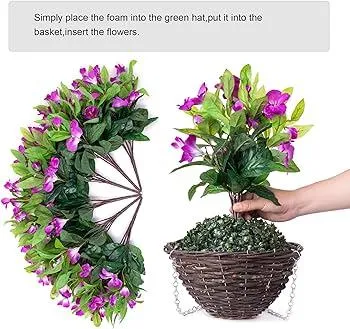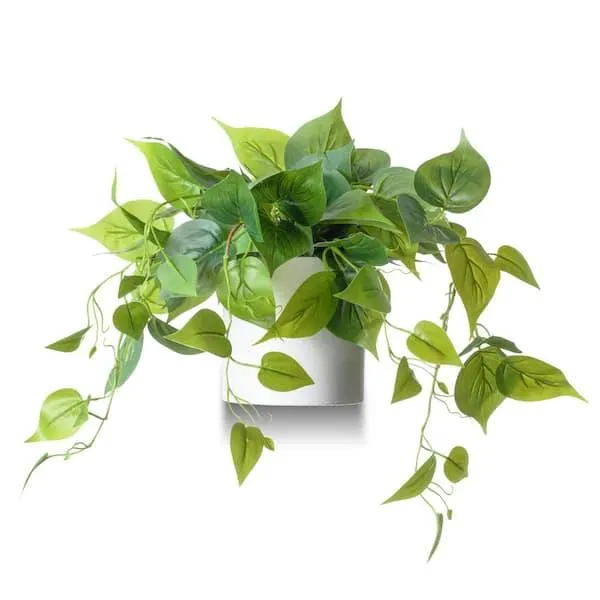Everything You Need to Know About Cascading Fake Plants
If you’re searching for “cascading fake plants,” chances are you’re looking to spruce up your home or office decor with some easy-to-care-for greenery. In this article, I will cover all the basics of using artificial cascading plants including popular styles, placement tips, care instructions, and more.
What are Cascading Fake Plants?
Cascading fake plants, sometimes called trailing plants, are artificial plant varieties designed to hang down or “cascade” over the edges of containers, baskets, or shelves. These faux foliage options don’t require watering like real plants and won’t die if you forget to care for them. They come in a variety of styles from succulents and vines to ferns and moss. Here are some of the most common cascading fake plant varieties:
- Ivy – Dense, dark green leaves in a trailing vine shape. Ivy is versatile and can fill large spaces.
- Succulents – Chubby, colorful leaves resembling echeveria, sedum, or other popular succulents. Great for boho decor.
- Ferns – Delicate, feathery fronds that give a lush, tropical vibe. Fern fronds can get quite long.
- Moss – Fluffy green or army green texture perfect for a muted, woodland feel. Moss styles have fine-textured fibers.
How to Place Cascading Fake Plants
From my experience styling rooms, cascading plants lend themselves well to certain placements. Here are some of the most effective ways to incorporate the trailing foliage styles:
- Hang in hanging baskets, window boxes, or plant stands near windows to catch natural light.
- Drape ivy or succulents over shelving, bookcases, or TV stands to soften their edges.
- Cram moss or ferns into nooks and crannies of wooden furniture like hutches or headboards.
- Pile succulents onto tiered plant stands or shelves to waterfall down each level.
- Weave ivy through curtain rods, railings, or open shelving for an instant lush backdrop.
The great thing about artificial plants is you don’t have to worry if they get sufficient sunlight. Use your creativity to find interesting nooks where foliage can spill over attractively!
Caring for Cascading Fake Plants
Compared to real plants, the care of faux varieties is a total breeze. Here are the basics:
- Dust them periodically with a dry microfiber cloth to remove any dust or dirt buildup.
- Straighten stems or leaves that get bent out of shape – just pinch or shape them back into place.
- Spot clean with a damp cloth if leaves get dirty. Avoid soaking or submerging the plant.
- Rearrange stems, vines, or leaves every few months to avoid flattening in one position.
- Replace if stems, vines or leaves get worn, damaged, or lackluster over many years.
I promise these plants will not die on you no matter how forgetful a gardener you are! They’re basically low-maintenance decor that you can enjoy without stress.
How to Style Cascading Fake Plants
Now that you know the styles and care tips, it’s time to get creative with styling! Faux plants are so versatile that you can mix and match them to complement any room’s vibe.

Here are some ideas from my own home which might spark your inspiration:
- Weave a trailing succulent garland along the mantel between framed photos.
- Tuck moss into a textured cube basket then place on an entryway table.
- Layer ivy in antique planters down a set of stairs for an outdoor “garden.”
- Accessorize a low bookshelf with ferns dangling over stacked books.
- String fairy lights through a curtain of ivy for a magical after-dark feel.
The possibilities are endless! With no worries of chemicals, watering slip-ups, or pests, you can focus on artistic styling instead of plant care.
FAQs About Cascading Faux Plants
Here are answers to some frequently asked questions I get from customers:
Do they look real?
With advanced fiber technologies, many high-quality faux cascading plants can fool the eye from a few feet away. It takes an experienced gardener to spot the difference up close.
Will animals/kids try to eat them?
Not likely since the materials don’t resemble real plants. But keep plastic varieties out of reach of curious nibblers just in case.

How long do they last?
Quality faux cascading plants can retain their looks for 5+ years with annual dusting/fluffing. Cheaper versions may crisp or discolor faster. Avoid direct sun exposure.
Can they get wet?
Most are water-resistant but not intended for full submersion. An occasional damp wipe or spray is okay, just don’t soak them.
Hope this guides you in finding the perfect cascading faux plants for your space! Let me know if any other questions come to mind.
In Closing
In summary, cascading fake plants are a low-maintenance way to bring lush greenery into your home without the fuss of real plants. From drooping succulents to fluffy moss, there are styles to complement any decorating aesthetic. With some creativity, you can find nooks of your space begging to be dressed with faux foliage. So get out there and start accessorizing! Before long, even your plant-challenged thumbs will be turning brown with envy. Happy styling!
Choosing the Right Cascading Fake Plant

| Plant Type | Watering Needs | Light Needs | Care Level | Good For |
|---|---|---|---|---|
| Pothos | Low | Low to Medium | Easy | Offices, bathrooms |
| Spider Plant | Low | Medium | Easy | Offices, bedrooms |
| Philodendron | Low | Low to Medium | Easy | Offices, living rooms |
| Chinese Evergreen | Medium | Medium | Easy | Living rooms, offices |
| Peperomia | Low | Medium | Easy | Offices, bedrooms |
FAQ
-
What kinds of fake plants are there?
There are basically two main types of fake plants. One is made of plastic materials that attempt to look similar to real greenery. The other uses materials like silk or other fabrics that are meant to copy plant leaves and stems.
-
How long will a fake plant last?
Most artificial plants can potentially last forever if you take good care of them. But perhaps they’ll only look their best for several years. Sunlight and dust can cause plastic plants to fade over time. Silk plants might get dusty too, or their colors could dull. With regular cleaning though, a fake plant could conceivably go on “living” for a very long time.
-
Are fake plants low maintenance?
While artificial plants don’t need watering like real ones, they still require some care. You’ll want to dust them occasionally using a soft cloth. And if there’s a lot of sunlight where they are displayed, you may notice fading over the months or years. So they basically need light dusting but basically don’t need watering like living plants do. Overall, fake plants are definitely lower maintenance than real greenery.
-
How can you tell if a plant is real or fake?
There are a few ways to sort of tell the difference between a living plant and a phony one. Real plants will obviously be able to grow and change over time. Their leaves may wilt or new growth could emerge. Fake plants generally stay static. Another test is to try bending a leaf or two – real ones can fold but artificial leaves often crack or break instead. And of course, a living plant will have roots!
-
Is it wrong to have only fake plants?
While real greenery has benefits like adding oxygen and helping clean the air, there’s nothing necessarily wrong with using artificial plants instead. Fake greenery can still improve a space visually. And for people allergic to real plants or who don’t have the ability to care for living ones, artificial is a fine option. Perhaps the choice mostly comes down to personal taste and what works best for each home or situation.
-
What are some pros and cons of owning fake plants?
Fake plants have advantages like being low maintenance as they don’t need watering. They also last longer than real ones without replacement. However, they don’t provide the alive atmosphere that natural plants do. Over time fake ones may fade or get dusty too. But on the other hand, for people allergic to pollen or unable to care for real plants due to busy schedules, artificial greenery can be the better alternative. It’s really about weighing the benefits against the drawbacks for each individual.
-
Should you use realistic or stylized fake plants?
There’s no right or wrong in choosing between realistic or more artistic fake foliage. It depends mainly on personal preference and the desired style for a space. Realistic ones strive to closely mimic nature, which some find appealing. However, stylized varieties can add modern flair or a graphic element. Perhaps the best way to decide is to examine how fake plants in different styles mixed with other decor might affect the look and vibe of a room. In the end, it comes down to what makes an individual happy.

-
Are indoor trees and citrus plants harder to care for than herbs or foliage plants?
Generally speaking, trees and fruit plants do require quite a bit more effort than lower maintenance greenery like many herbs or foliage plants. Trees and citrus in particular demand proper soil, light exposure, watering and sometimes pruning or training. Their larger size also means bigger plants to lug around. Leafy houseplants tend to be far more forgiving of imperfect care. So if you’re new to keeping houseplants or don’t have much time, simpler plants are likely the easier route to go. Perhaps start small before trying a miniature indoor orange tree!
